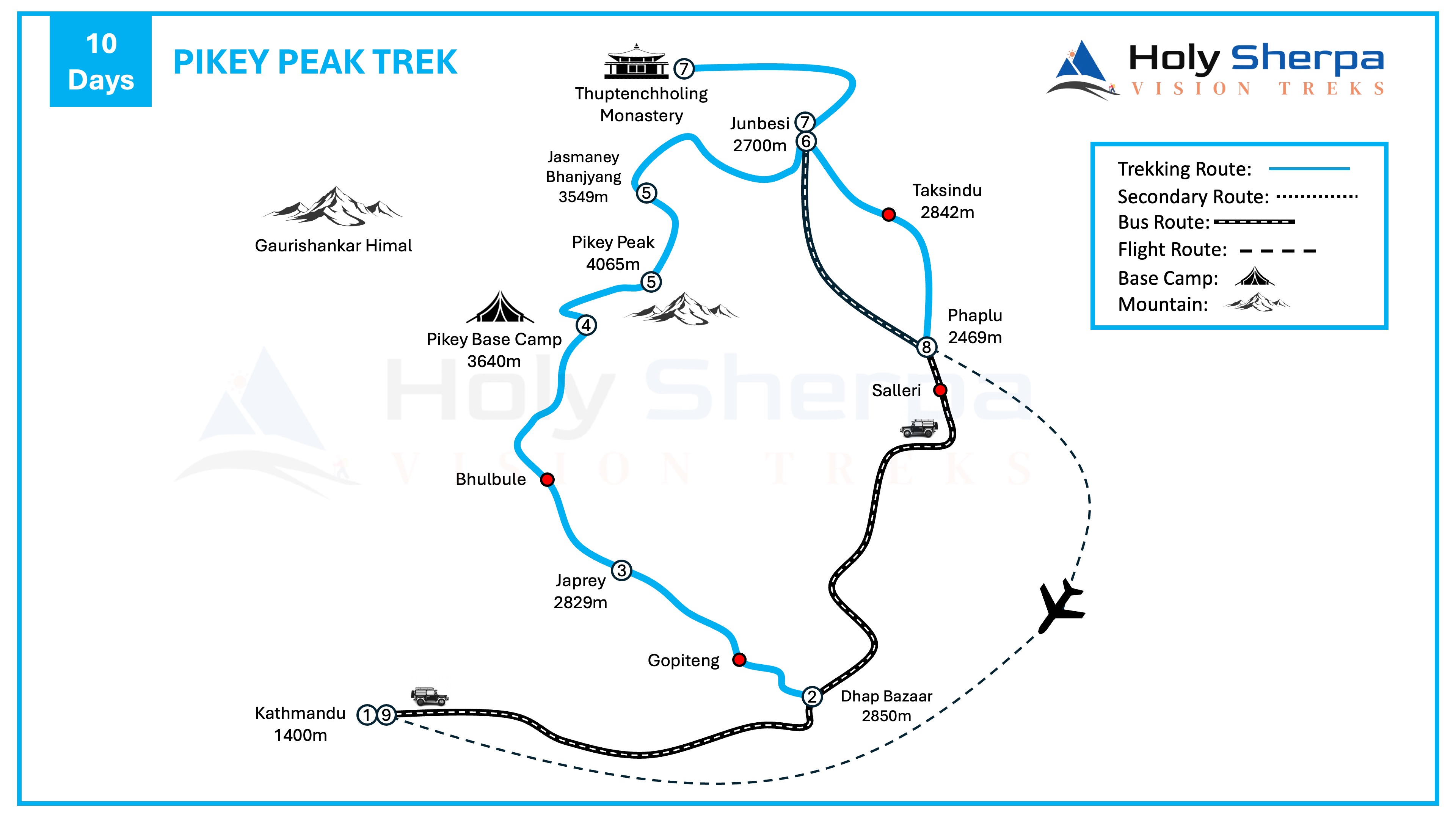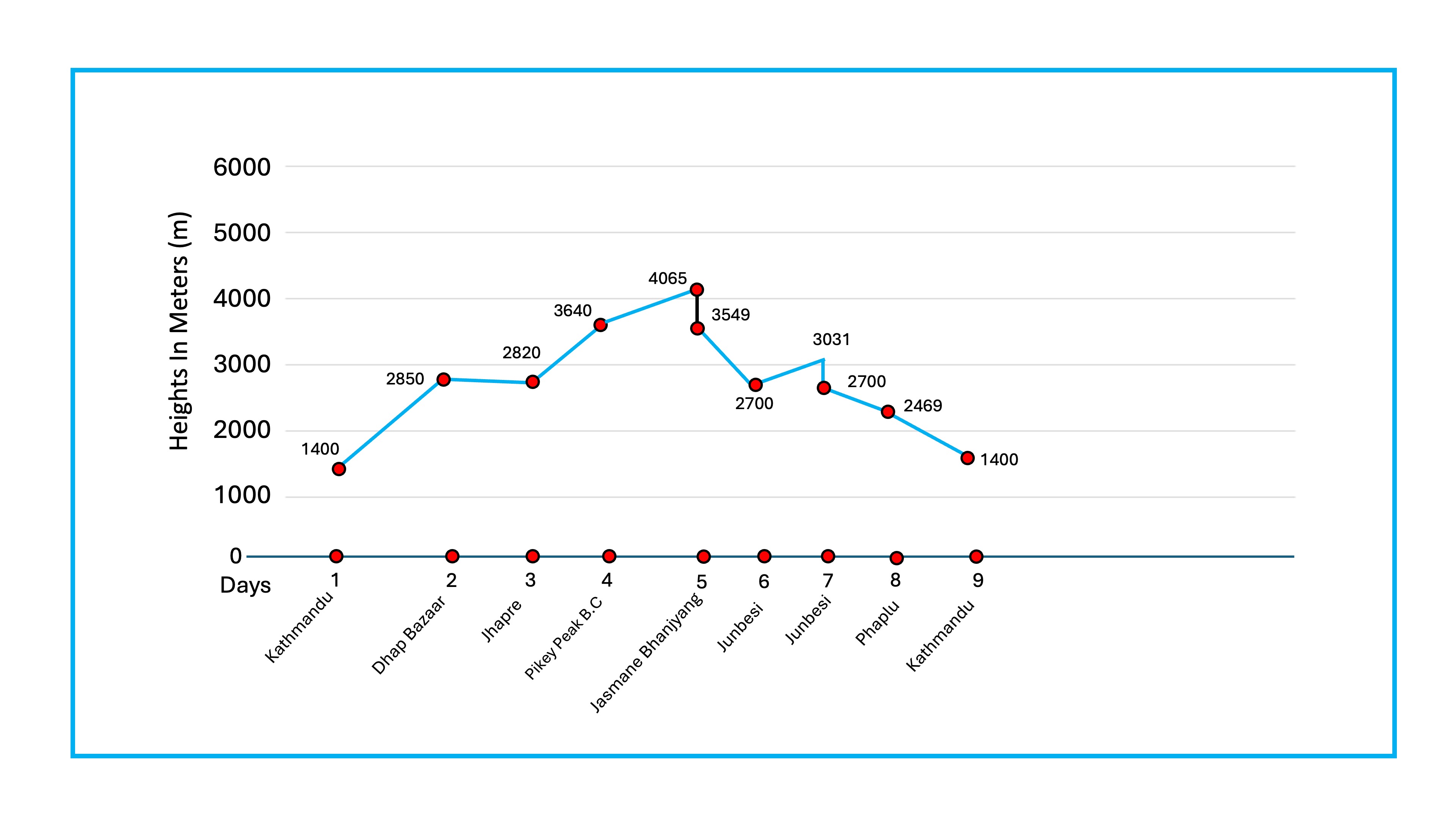Pikey Peak Trek – The Hidden Gem of the Lower Everest Region
The Pikey Peak Trek is one of Nepal’s most beautiful yet less-traveled trekking routes, offering a perfect mix of stunning Himalayan views, rich culture, and peaceful nature. Nestled in the lower Everest region, this trek is an ideal choice for those seeking a short adventure with authentic experiences, away from the busy trails of Everest Base Camp or Annapurna.
At 4,065 meters, Pikey Peak rewards trekkers with a sunrise view that is nothing short of magical. As the first rays of light touch the snow-capped mountains, you’ll witness a sweeping panorama that stretches from Mount Everest and Lhotse to Makalu, Kanchenjunga, Dhaulagiri, Manaslu, and the Annapurna range. Many trekkers believe that this is one of the best viewpoints in Nepal to see Everest in all its glory.
But the trek is much more than just the mountains. Along the trail, you pass through dense rhododendron forests, bamboo groves, rolling hills, and yak pastures, creating a constantly changing scenery. In spring, the forests bloom with red and pink rhododendrons, turning the hillsides into a vibrant canvas. Wildlife lovers may also spot Himalayan birds and animals along the way.
The cultural experience is equally rewarding. The region is home to the Sherpa people, who welcome trekkers with warm hospitality. You can explore Buddhist monasteries, mani walls, prayer flags, and chortens, all of which reflect the deep spiritual traditions of the Himalayas. Staying in local tea houses or homestays gives you the chance to share stories with the villagers, taste authentic Sherpa dishes, and gain a deeper understanding of their lifestyle.
One of the biggest advantages of the Pikey Peak Trek is its flexibility. It can be completed in 5 to 7 days, making it suitable for trekkers with limited time. Despite being relatively short, the trek doesn’t compromise on beauty, cultural richness, or adventure. The trails are peaceful, meaning you can truly immerse yourself in the landscapes without the crowds often found on other routes.
Whether it’s the majestic Himalayan sunrise, spiritual encounters, vibrant Sherpa culture, or tranquil trails, the Pikey Peak Trek is a hidden gem that captures the true essence of trekking in Nepal. It’s an adventure that leaves you with lifelong memories of both nature and people.
Highlight of the Pikey Peak Trek
Upon your arrival at Tribhuvan International Airport, our friendly representative will greet you and escort you to your hotel. Take the day to rest, recover, and immerse yourself in the vibrant atmosphere of Kathmandu, preparing for the adventure that lies ahead.
After breakfast, enjoy a scenic drive from Kathmandu to Dhap Bazaar. Pass through lush valleys, winding rivers, and charming local villages along the way. Arrive at Dhap Bazaar and soak in the serene mountain views, while getting ready for the trek ahead.
Step onto the trail and begin your trek through rhododendron and pine forests, terraced farmlands, and traditional Sherpa villages. The day is filled with picturesque landscapes, fresh mountain air, and glimpses of distant Himalayan peaks. Arrive in Jhapre and enjoy the warm hospitality of the local community.
Ascend through alpine terrain, passing quiet forests, cascading streams, and open ridges. Reach the Pikey Peak Base Camp and prepare for the highlight of your trek. Marvel at the tranquil surroundings and majestic mountain vistas, perfect for capturing memories.
Rise early for a memorable climb to the summit of Pikey Peak. From the top, enjoy panoramic views of Everest, Kanchenjunga, and the surrounding Himalayan giants. After soaking in the breathtaking scenery, descend to Jasmane Bhanjyang for a peaceful overnight stay, reflecting on this once-in-a-lifetime experience.
Descend gradually through forests, terraced fields, and quaint villages until reaching Junbesi, a charming Sherpa village known for its monasteries, warm hospitality, and traditional way of life. Take in the tranquil ambiance and mountain views that surround this beautiful village.
Enjoy a well-earned rest day. Explore Junbesi at your leisure, visit the Thuptenchholing Monastery, or hike to a nearby viewpoint for more stunning panoramic views of the Himalayas. This is a perfect day to absorb the culture and serenity of the region.
Continue your descent through peaceful trails, passing local villages, forests, and terraced fields. Reach Phaplu and take in the tranquil beauty of the lower Himalayan landscape, preparing for your return journey.
Embark on a scenic drive back to Kathmandu, retracing your way through valleys, rivers, and quaint settlements. Upon arrival, check into your hotel and enjoy a relaxing evening in the vibrant city, perhaps sampling local cuisine or shopping for souvenirs.
After breakfast, transfer to Tribhuvan International Airport for your onward journey. Carry with you the memories of soaring peaks, peaceful villages, and the warmth of the Himalayan people, marking the perfect conclusion to your Pikey Peak adventure.
Airport pick-up from Tribhuvan International Airport (arrival date & time)
Transportation from Kathmandu to Dhap Bazaar (pre-trek)
3 meals per day (breakfast, lunch, dinner) during trek
Accommodation during trek
All necessary Gaurishankar Conservation Area Permit (GCAP) and the TIMS Card
Experienced English-speaking guide with meals, accommodation, transport, salary, insurance & equipment
Transportation from Dhap Bazaar to Kathmandu (post-trek)
Airport drop-off (departure date & time)
International airfare to/from Nepal
Nepal entry visa fee
Travel insurance covering emergency evacuation and medical expenses
Extra hotel nights in Kathmandu in case of early arrival or late departure
Personal refreshment expenses (soft drinks, hard drinks, bottled water, cigarettes, chocolates, etc.)
Utility expenses (telephone, electricity for charging, internet/Wi-Fi, laundry, etc.)
Tips for trekking support crew


Basic Info about Pikey Peak Trek
1. Location:
The Pikey Peak Trek is located in the Lower Solukhumbu region of Nepal, south of Everest. It lies in a quieter part of the Khumbu area, away from the crowded Everest Base Camp trails, yet still offers majestic Himalayan scenery and authentic Sherpa culture.
2. Altitude:
The highest point of the trek is Pikey Peak (4,065 m / 13,333 ft). From the top, trekkers are rewarded with one of the best panoramic Himalayan views in Nepal, including Mount Everest, Makalu, Lhotse, Kanchenjunga, Dhaulagiri, and Annapurna, along with countless other peaks.
3. Trek Duration:
This trek usually takes 7 to 10 days, depending on your chosen route and pace. It’s one of the shorter treks in Nepal, making it a great choice for trekkers with limited time but who still want a remarkable Himalayan experience.
4. Trek Difficulty:
Pikey Peak is considered an easy to moderate trek, suitable even for beginners. The trails are less steep compared to higher Himalayan treks, but a reasonable fitness level is needed, as you’ll be walking several hours a day at altitude.
5. Best Seasons:
The best time to trek is in spring (March–May) and autumn (September–November), when the skies are clear, rhododendrons are in bloom, and mountain views are breathtaking. Winter can also be rewarding for those who enjoy snow, while summer is less ideal due to monsoon rains.
6. Accommodation:
Along the trail, trekkers stay in local tea houses and homestays. The lodges are simple but cozy, serving traditional Nepali food like dal bhat, noodles, soups, and Tibetan bread. Staying with locals adds an authentic cultural touch to the trek.
7. Major Attractions:
The main highlight is the panoramic sunrise view from Pikey Peak, often described by Sir Edmund Hillary as his favorite Everest view. The trek also passes through Sherpa villages, ancient monasteries, chortens, prayer flags, lush rhododendron forests, and yak pastures, giving trekkers both natural beauty and cultural immersion.
8. Permits Required:
Trekkers are required to obtain two permits: the Gaurishankar Conservation Area Permit (GCAP) and the TIMS Card (Trekkers’ Information Management System). The GCAP is necessary as the trail passes through the Gaurishankar Conservation Area, supporting conservation and sustainable tourism, while the TIMS card ensures trekkers’ information is registered for safety and rescue purposes.
Free cancellation
No Deposit Required